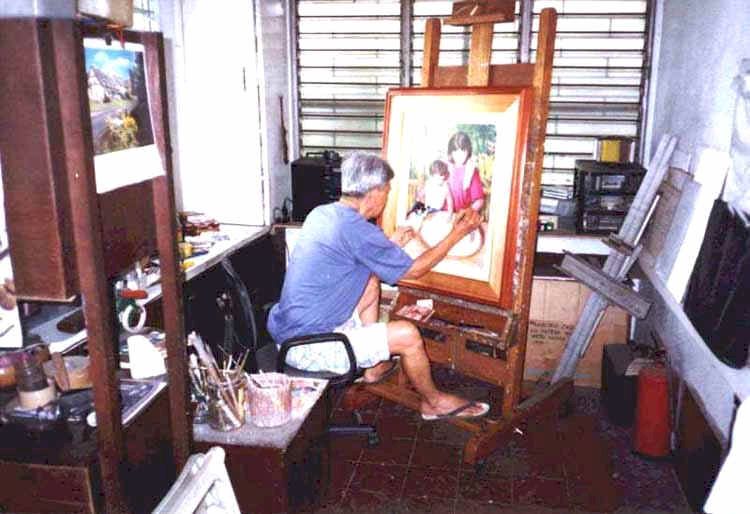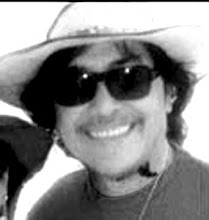 |
From the start, I was already adept at drawing. So whatever ah, blank paper
I could get hold of and a pencil or a... or crayolas, I’d, I’d ah...do drawings.
Like his parents and older siblings, Leynes went to the University of the Philippines (U.P.) for his college education, entering the School of Fine Arts. His studies were interrupted however, when Japan invaded the Philippines. Two days after Pearl Harbor was bombed, he married Amalia Alcantara, his childhood sweetheart and next-door neighbor.
I was in the graduating class, in the fourth year, when the World... the World
War II broke out in December. Our family had a bakya... a small bakya factory,
and I was one of the carvers. And I also designed the, what they call the dahon
‘no? or the... the cover of the bakya.
In 1945, during the American period, Leynes earned a living by sketching portraits of passing American GI’s for five pesos. He set himself up at the entrance of a big drug store on Rizal Avenue paying the owner a small amount for the space rental.
When the war ended and the School of Fine Arts, U.P. School of Fine Arts
opened, I didn’t ah, enter the school anymore because I was married and I had
to earn a living. So I ah, I ah, had to go to... to work and I was admitted into
the Ramon Roces Publications where I did illustrations for the magazines
principally Liwayway. I was ah, offered the job of ah, staff artist of one of the
pioneer advertising agencies at that time which was the Philippine Advertising
Counsel and had the San Miguel, the Magnolia, th Coca-Cola accounts. After
Philippine Advertising Counsel, I was ah, offered the position of ah, art director
and head of the art department(and later as EVP for Art Dept.) by ah, Javier
Romero> who... who owned the J. Romero and Associates Advertising Agency.”
Only in 1980, at the age of fifty-eight, did he retire from the advertising field and started painting full-time. For it was only at this time that artists became grist for the media and were able to demand huge sums for their work (Duldulao, The Philippine Art Scene 23).
I ah, worked fully or full-time on my career as a painter only in 19... 1980.
And I wish I had started earlier. And I, because I, one of my regrets is I
cannot paint monumental pieces because of physical incapacity.
Discounting his art lessons as a child, Leynes’ formal training began in U.P. School of Fine Arts. In this prestigious university, he learned from and was influenced by his professors, among them, Fernando Amorsolo, Ireneo Miranda, Macario Peralta, Toribio Herrera, Pablo Amorsolo and Vicente Alvarez Dizon. It was here that he received Pablo Amorsolo’s advice to master the art of drawing first, after which all the rest would follow,” (Guillermo 362).
Well I was lucky to be a student of art in that period because I had the
the best painters in the land as my instructors, professors... and the likes
of ah, Fernando Amorsolo and Pablo Amorsolo and Miranda and ah, Rivera
-- Emir and ah, Castañeda and Guillermo Tolentino. Inevitably, one will ah...
will ah, adapt the style of the professor which is ah, ah, understandable
since he is… he’s in the atmosphere where he ah, admires or idolizes his…
his instructors.”
Of his professors, the greatest influence on him was Fernando Amorsolo. According to Leynes,
Fernando Amorsolo is the only painter who has really captured the true
color and essence of the Philippines, (Visions 109).
Some claim that his works are copies of Amorsolo and Leynes is the typical student emulating his instructor. However, his style is quite different. In an interview conducted by Dr. Rodolfo Paras-Perez, Leynes tells us of Amorsolo:
If I so adopt his attitude towards light and its effect on the Philippine
environment, it is because it is compatible with my purpose, (Visions 109).
Amorsolo is is ah, impressionist, I mean, he paints in a manner that’s
not very detailed. So I... I merely took one step ah ahead one step
farther than Amorsolo and put in the details.
Leynes’ style of painting has been called Magic Realism, Hyper Realism, Super Realism and Macrovision, which means the representation of everyday scenes in a detailed manner. Not always a realist, he first experimented with different styles such as abstraction, expressionism, cubism, etc. It was only in 1976, at the age of fifty-four, did he discover the realist style of American painter, Andrew Wyeth. In 1977, in an exhibit in Impressions Gallery, his painting, Bigas, received wide acclaim for its artistry and detail (Guillermo 362).
While in the ah, art department of that ah, advertising ah, agency, I had some
ah, some of my artists who were ah, interested who were ah, who idolized
Andrew Wyeth. So we decided to form a group which we named the Magic
Realist and which... which we... and which we followed the style of Andrew
Wyeth. Members of the group were one of my art dire... directors, Ger Viterbo,
who is now dead, there was ah, Jose Barcelona...Joselito Barcelona, and
Manuel Llado and Jaime Roque.
Though Leynes’ style was American in origin, his works remain distinctly Filipino and unique. Initially inspired by Wyeth, he later diverged from its works and attitudes (Visions 108). Dr. Paras-Perez is reluctant to use the term Magic Realists for the group for the reason that their works are anything but an imitation of Wyeth’s. He says,
There is too much of the now in their vision and the will to set up a macrolens’ preoccupation not seen in their presumed counterpart abroad, (Visions 2).
Right now, the Magic Realism in the Philippines is slightly different.
It has a local ah, local ah, effect. Andrew Wyeth ah, lived in Maine,
in the U.S. and It is a very cold place. And in his ah, in the place he lived,
the atmosphere was bleak, and the ah, the atmosphere was gray and
browns. I... I couldn’t ah, live with that kind of ah, of ah, attitude towards
my art because it is not my atmosphere. I live in the Philippines and like
Amorsolo, I project what I see, the atmosphere I see around.
The effects that make a painting distinctly Leynes, are his perfection of detail and the sense of being more real than real. His paintings look so real in fact, that a humanities teacher once accused his bigas paintings of being fake that they are real grains pasted on canvas. Though he uses pictures as a basis for his paintings, mere photographs are hardly comparable to a Leynes painting. In the same interview with Dr. Paras-Perez, Leynes says,
A photographer captures what is there and what he sees. A painter has
the power to change and rearrange what he sees. As a realist I, consider
the camera as an important tool in my art equipment. The camera broadens
the artist’s horizon. With the camera’s aid I can freeze the action, capture an
expression or a particular sunlight effect, compose from an unusual angle
orviewpoint. Even while I am merely looking through the viewfinder of my
camera I am already in the process of creating. But I prefer whenever
possible to have the original or live model in front of me when I am in the
painting stage. The photograph is merely used as a stable reference and never
copied as is. Move a tree, change an expression, crop extraneous details, add,
subtract and as the song goes eliminate the negative, accentuate the positive.
It is not merely a case of ‘have photograph, will paint’ as some critics
will put it, (Visions 107).
Truly nationalistic, Leynes’ is known for his Filipino theme. Deeply rooted in culture, his art pays homage to the Filipino tradition and way of life (Duldulao, A Century of Realism in Philippine Art 253).
Common images are a woman sifting bigas, a kalabaw with its wares, a tindera of Filipino fruits, harvest scenes and sandok at palayok. His panata also calls for a painting of Christ every Good Friday. His favorite however, is the mother and child.
Partly to a devotion to the Blessed Mother and also because I had a... a
slew of models. I have ah, twelve grandchildren and in their babyhood
I had the opportunity to take pictures of... of the babies and their mothers.
Whatever the image, the atmosphere of a Leynes painting is one of serenity, peace and of a good life and therefore lacks social relevance. Far from being apathetic to society and its affairs, Leynes is an avid follower of current events. In recent years, afternoons find him more often watching the news or reading Time magazine than painting. It is simply not his nature to splash his politics and opinions on canvas.
I leave that to the other artists the social realists. I have no intention of ah,
of ah, correcting or trying to cure the ills of society. I merely want to paint
what I feel.
When I was quite young, I entered my lolo’s studio unseen by anyone. Mimicking his usual activity, I dipped his paintbrush in the paints on his palette and proceeded to paint over his work. Discovered, Lolo would not let me be spanked or rebuked but hung a hook just out of reach of small children on his studio door from then on. In high school, not having inherited an ounce of artistic talent, I enlisted Lolo’s help on a Christian Living project. I asked him to draw me a Virgin Mary on plain cartolina and requested, ...Wag niyo pong gandahan,(I was hoping to pass the work off as mine). Fifteen minutes later, he handed me back my cartolina with his version of ‘hindi maganda’. I received a grade equivalent to 2.0 for my project, not having convinced my teacher I made the drawing. Not in the least disappointed, I had Lolo sign his work after it was returned to me and framed the sketch.
Though to most people, the word artist brings images of long-haired, unkempt, passionate, and rebellious young men, what comes to my mind when I hear artist is a picture of my lolo quietly painting in his studio while listening to classical music. Somewhat of a recluse, he only occasionally leaves his studio to spend some time with his seven children and twelve grandchildren, on Sundays. At the age of seventy-seven, Lolo usually spends the rest of the week watching television the news or the Discovery channel. Asleep at 7 p.m. and awake at 5 a.m., the most that he and Lola would do for the day would be to go to Megamall to eat in Triple V or walk the four blocks to Church to attend mass. Various aches and pains, and perhaps the laziness that is allowed people of his age, lead him to paint less and less these days. While still working on a piece, buyers have already reserved it and a queue already formed for his following works. He usually paints small pieces now in watercolor or colored pencils though he still paints in oil or acrylic occasionally.
My great pride and admiration for my lolo does not stem only from his immense artistic talent but also from his intelligence, wisdom, firm principles and generous heart. A quiet, unassuming man, he is not demonstrative of his affection. Be that as it may, none of his children and especially grandchildren could ever doubt his deep love for his family. For me, the beauty of a Leynes painting lies not in its colors, details or forms, but in the man who made it.
by
Jennifer Leynes

No comments:
Post a Comment